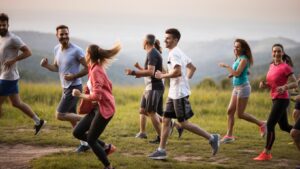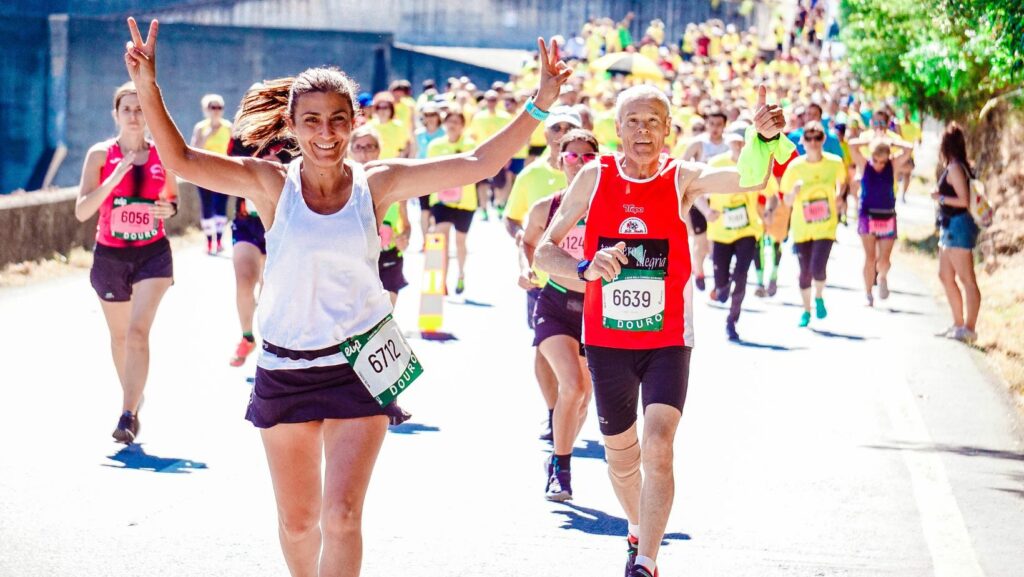Running Sports
- Diverse Running Sports: Running encompasses a variety of events such as marathons, half marathons, and trail runs, each offering unique experiences and challenges for participants.
- Health Benefits: Participating in running sports improves cardiovascular health, boosts muscular strength, supports weight management, and promotes mental well-being through stress reduction and mood enhancement.
- Essential Gear: Proper running equipment, including supportive shoes, moisture-wicking clothing, and hydration systems, enhances performance, safety, and overall enjoyment during runs.

- Structured Training: Effective training plans, whether for beginners or advanced runners, are crucial for building endurance, improving speed, and minimizing injury risks, making structured approaches essential for success.
- Community Engagement: Running fosters a strong sense of community and social interaction, encouraging runners to connect through events and shared experiences, thus enhancing overall motivation and enjoyment.
- Technological Advancements: Modern running gear, including smart footwear and wearable monitors, provides valuable performance insights, aiding athletes in optimizing their training and achieving their goals.
Running sports have captivated athletes and enthusiasts alike for centuries. From the adrenaline-pumping thrill of competitive races to the serene joy of a morning jog, running offers a unique blend of physical challenge and mental clarity. It’s not just a sport; it’s a lifestyle that promotes health, community, and personal growth.
As more people embrace running, the variety of events and styles continues to expand. Whether it’s marathons, trail runs, or fun runs, each offers its own set of challenges and rewards. This article delves into the world of running sports, exploring the benefits of participating, the best practices for training, and the vibrant culture that surrounds this timeless activity.
Overview Of Running Sports
Running sports encompass various forms of competitive and recreational running, appealing to diverse audiences around the world. Their history and evolution shape the current landscape, which includes numerous events and styles.
History Of Running Sports
Running sports trace back to ancient times, with evidence found in early civilizations. The first recorded Olympic event in 776 BC featured a footrace called the stadion. Over centuries, running evolved as both a competitive and recreational activity, seen in events like long-distance running and races organized by communities. The 20th century brought significant developments, including the establishment of various race formats and the popularization of marathons, influenced by iconic events such as the Boston Marathon, first held in 1897. The introduction of running organizations and governing bodies further standardized competitive practices.
Popular Types Of Running Sports
Running sports comprise several distinct types, each offering unique experiences:
- Marathons: Cover a distance of 26.2 miles, testing endurance and mental strength.
- Half Marathons: Succeed at 13.1 miles, providing a challenging yet more accessible distance.
- Trail Running: Focuses on natural terrains, enhancing the connection with outdoor environments.
- Track and Field: Includes various distance races, featuring sprints to long-distance events.
- Ultramarathons: Exceed marathon distances, often involving challenging conditions and extreme endurance.
- Obstacle Course Races: Combine running with physical challenges, providing a blend of obstacle navigation and speed.
Each type appeals to different athletes, fostering a community of competitive and casual runners alike.
Benefits Of Running Sports
Running sports offer numerous benefits that enhance both physical and mental well-being. Engaging in running not only strengthens the body but also promotes a positive mindset.
Physical Health Benefits
Running sports provide substantial physical health benefits by improving cardiovascular fitness, increasing bone density, and aiding weight management.
- Enhances Cardiovascular Health: Regular running strengthens the heart, lowers resting heart rate, and improves blood circulation.
- Improves Muscular Strength: Running engages various muscle groups, particularly in the legs, hips, and core, leading to increased muscle tone and strength.
- Supports Weight Management: Running burns significant calories, supporting effective weight loss or maintenance efforts.
- Boosts Immune Function: Moderate running can enhance immune response, reducing the risk of illnesses.
- Promotes Joint Health: Contrary to misconceptions, running can improve joint function in those without existing injuries, as it strengthens the supporting muscles and ligaments.
Mental Health Benefits
Running sports also significantly contribute to mental health, fostering emotional resilience and cognitive clarity.
- Reduces Stress: Running stimulates the production of endorphins, leading to decreased stress and anxiety levels.
- Enhances Mood: Regular running combats depression and boosts overall mood, providing a natural source of happiness.
- Improves Cognitive Function: Studies show running enhances memory, focus, and problem-solving abilities by promoting better blood flow to the brain.
- Encourages Social Interaction: Participating in running events cultivates a sense of community and belonging, enhancing social well-being.
- Fosters Discipline and Resilience: Committing to a running routine instills discipline and builds resilience, transferable to various life challenges.
Equipment And Gear For Running Sports
Essential equipment enhances performance, safety, and enjoyment in running sports. Understanding the necessary gear and any advancements in running technology can significantly impact an athlete’s experience.
Essential Running Gear
- Running Shoes
Running shoes provide the needed support and cushioning. Selecting shoes based on foot type and running style helps prevent injuries and improves comfort.
- Moisture-Wicking Clothing
Moisture-wicking materials draw sweat away from the skin, keeping the runner dry. These materials contribute to temperature regulation during runs.
- Hydration Systems
Hydration systems, including bottles, belts, and vests, enable runners to stay hydrated on longer distances. Consistent fluid intake maintains performance and prevents dehydration.
- Socks
High-quality running socks minimize blisters and provide cushioning. Choosing socks made from synthetic fibers often offers better moisture management compared to cotton.
- GPS Watches
GPS watches track distance, pace, and route. Using GPS technology ensures accurate tracking of performance metrics during both training and races.
- Reflective Gear
Reflective gear enhances visibility, especially during early morning or late evening runs. Wearing bright colors and reflective accessories enhances safety.
- Smart Footwear
Smart footwear integrates technology that tracks running metrics and provides real-time feedback. This technology aids runners in analyzing performance and optimizing their training.
- Wearable Monitors
Wearable monitors track heart rate, cadence, and other physiological metrics. Utilizing these devices supports improved training efficiency and injury prevention.
- Running Apps
Running apps offer training plans, community features, and tracking capabilities. Engaging with these applications can enhance motivation and provide valuable insights into performance.
- Performance Fabrics
Advanced performance fabrics feature moisture control, breathability, and thermal regulation. Using these fabrics contributes to overall comfort and performance during runs.
- Smartphone Integration
Many running devices integrate with smartphones, allowing for seamless tracking and sharing of performance data. This connectivity fosters community interaction and progress evaluation.
Training Techniques For Running Sports
Training for running sports involves structured plans catering to various skill levels, ensuring optimal performance and reducing the risk of injury.
Beginner Training Plans
Beginner training plans focus on building endurance and establishing a running routine. They typically include:
- Walk-Run Intervals: Incorporate walking and running intervals to gradually increase running time. Start with a ratio of 1 minute running to 2 minutes walking.
- Long Runs: Dedicate one day a week to a long run, slowly increasing distance by 10% each week to develop stamina.
- Rest Days: Schedule rest days to allow the body to recover, minimizing injury risk and fatigue.
- Cross-Training: Engage in activities like cycling or swimming to improve cardiovascular fitness without excessive strain on running muscles.
- Strength Training: Include bodyweight exercises or light weights twice a week to enhance overall strength and prevent imbalances.
Advanced Training Strategies
Advanced training strategies integrate higher intensity and specialized workouts. Key components include:
- Tempo Runs: Perform tempo runs at a challenging pace to improve lactate threshold, typically around 20-40 minutes at a steady, fast pace.

- Interval Training: Complete short, intense intervals of 400 meters to 1 mile, with rest periods in between to enhance speed and recovery.
- Hill Repeats: Run uphill repeats to develop leg strength and cardiovascular fitness, focusing on maintaining form during climbs.
- Long Runs with Pace Work: Incorporate segments at race pace within long runs to simulate race conditions and build mental toughness.
- Recovery Runs: Mix in easy recovery runs to promote blood flow and healing while minimizing strain on the body.
Implementing these techniques fosters growth and progression in running sports, helping athletes achieve their performance goals.
New Goals to Achieve
Running sports offer a unique blend of physical challenge and mental clarity that resonates with many. They create opportunities for personal growth and foster a sense of community among participants. With a variety of events available runners can find the perfect fit for their interests and abilities.
The benefits of running extend beyond physical health to encompass mental well-being. This timeless activity encourages a lifestyle that prioritizes fitness and resilience. As technology continues to advance the experience of running will only improve enhancing performance and community engagement.
Ultimately embracing running sports can lead to a healthier and more fulfilling life. Whether someone is a beginner or an experienced athlete there’s always a new path to explore and new goals to achieve.

